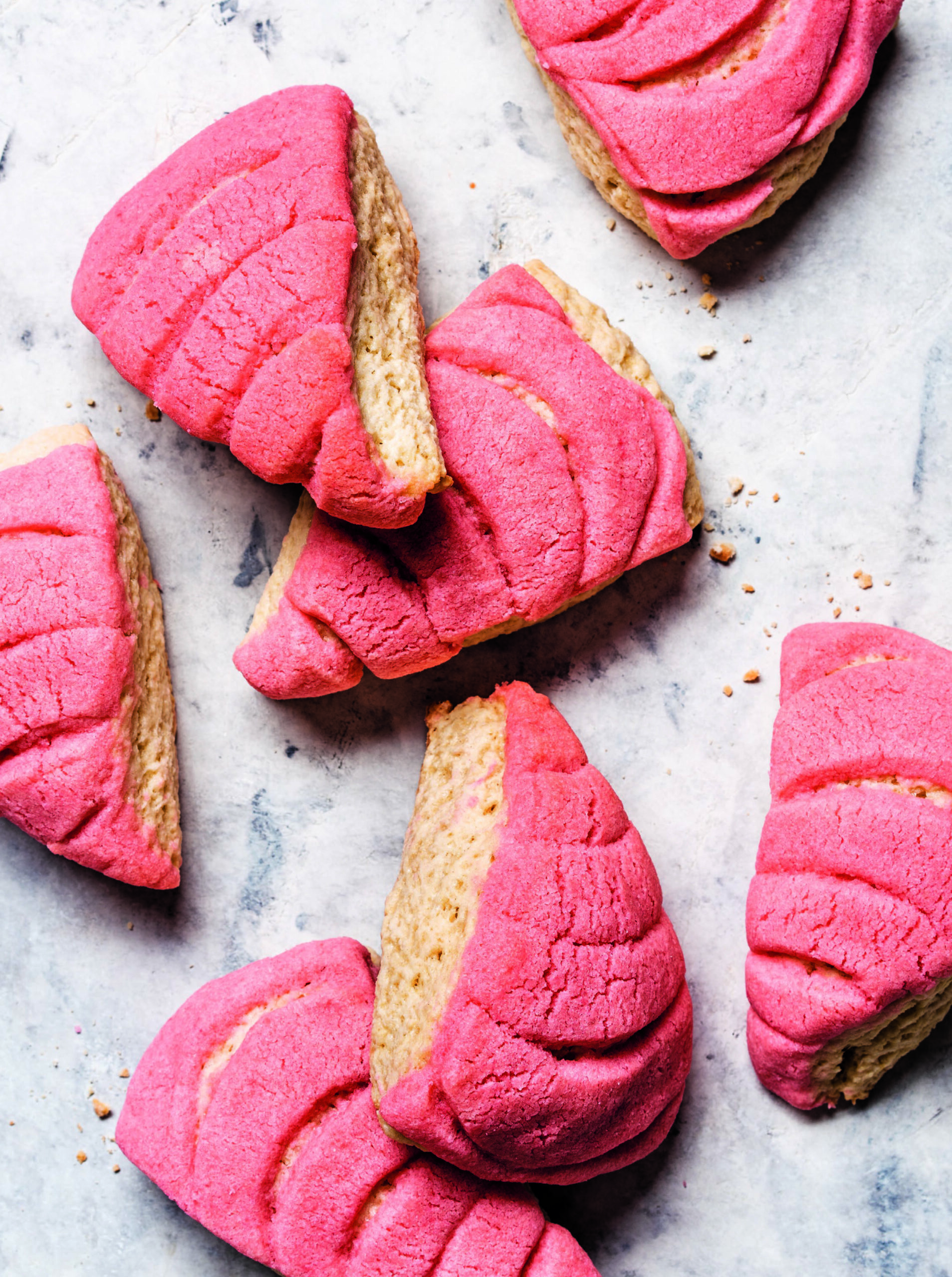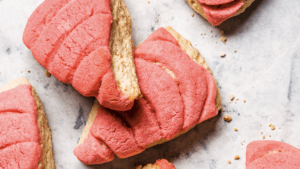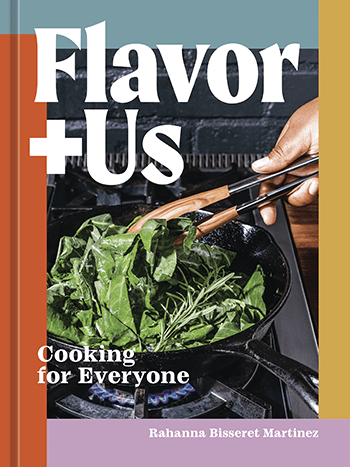
I love the brilliance of Mexican desserts. In many ways, Mexican desserts are actually not super sweet. Historically, the sugar used is not a white granulated sugar but a sugar called piloncillo, which has brown-sugar-molasses richness. I have so many memories of my abuelita and us drinking cinnamon tea and eating pan dulce. The cream-filled horn (curerno) or the molasses-rich pig-shaped cookie (marranito) are iconic favorites, but for me, the concha is pure perfection. It is hardy enough to withstand a dunk into coffee con leche, Mexican cinnamon tea, or Mexican hot chocolate without crumbling or adding too much sweetness. A scone is similar to me in that it doesn’t need to be too sweet (or even sweet at all).

Concha Scones
Ingredients
For topping:
- 1/2 cup all-purpose flour
- 1/4 cup unsalted butter, at room temperature
- 1/3 cup natural cane sugar
- 5 drops red food coloring
For scones:
- 2-1/4 cups all-purpose flour
- 1/2 cup natural cane sugar
- 1/2 teaspoon salt
- 1-1/2 teaspoons baking powder
- 1/2 cup (1 stick) unsalted butter, at room temperature
- 1 egg lightly beaten
- 1/2 cup whole milk
Instructions
To make the topping:
- In a small bowl, use a fork to combine the flour, butter, sugar, and red food coloring. Once the butter has been incorporated, use your hands to knead the topping dough into a smooth texture. You may want to wear gloves to prevent the food coloring from tinting your hands pink. The mixture should resemble a light pink sugar cookie dough. Set the mixture aside.
To make the scones:
- In a large bowl, whisk together the flour, sugar, salt, and baking powder. Once everything is combined, add in the butter. Using a fork, press and stir the butter until the dough forms little pea-sized balls. Add the egg and milk. With the fork or a rubber spatula, slightly stir together the ingredients just until the flour is almost incorporated. It should look sandy and dry on the outside. Empty the dough onto a cutting board. Fold the dough over onto itself until it looks evenly moist with small dots of butter. Gently press the dough into its original bowl, almost as if it’s a mold. Set aside.
- Preheat the oven to 350°F. Line a baking sheet with parchment paper or aluminum foil and set it aside. Roll the topping into a ball and place onto a piece of parchment paper, wax paper, or plastic wrap. Roll or press the topping out into a 5-to 6-inch circle.
- Flip the bowl with your dough over onto a cutting board, and flatten into a 5-to 6-inch disc. Place the topping on top of the scone dough with the parchment paper facing up. Carefully remove the parchment paper from the topping and gently press the topping to seal it to the scone dough. This should look kind of like a frosted sugar cookie.
- With a large chef’s knife, cut the dough into 8 triangular pieces. To decorate the scones, you can get creative or stick to more traditional designs. I like to cross hatch the topping of the scones with a paring knife, or make the more traditional cut of five curved lines along the top meant to resemble a concha (or shell). The knife should score right before it reaches the actual scone dough. If you don’t want to use a knife, you can make the curved lines with a metal measuring cup. Hold the cup facing downward and press one edge of the cup down into the topping to make five evenly spaced curved lines. Once all the scones have a design, arrange them at least 11⁄2 inches apart on the prepared baking sheet. Chill in the fridge 10 minutes before baking. Bake for 20 minutes, or until the bottom edges start to look golden brown. Let cool for at least 10 minutes. Serve immediately or store in a sealed bag or container for up to 1 week.
Notes
 Recipe reprinted with permission from Flavor+Us: Cooking for Everyone by Rahanna Bisseret Martinez (Ten Speed Press, an imprint of Penguin Random House, 2023). Photography by Ed Anderson.
Recipe reprinted with permission from Flavor+Us: Cooking for Everyone by Rahanna Bisseret Martinez (Ten Speed Press, an imprint of Penguin Random House, 2023). Photography by Ed Anderson.
